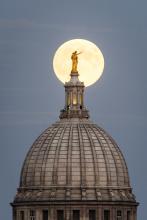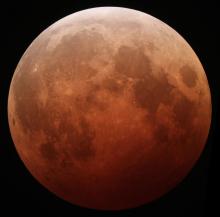Listen to today's episode of StarDate on the web the same day it airs in high-quality streaming audio without any extra ads or announcements. Choose a $8 one-month pass, or listen every day for a year for just $30.
You are here
Moon and Companions
Two bright companions will keep pace with the Moon tonight. The brighter of the two is Jupiter, the biggest planet in the solar system. It’s well to the left of the Moon at nightfall — the brightest object in the sky at that time other than the Moon.
The second companion is the star Antares, the heart of the scorpion. It’s a little closer to the lower left of the Moon.
There are many words to describe the phases of the Moon and how the phase is changing. Tonight, it’s technically known as a waxing crescent. It’s a fat crescent, because the Sun lights up more than a third of the lunar hemisphere that faces Earth.
It’s called a “waxing” Moon because the fraction that’s illuminated is getting bigger by the night. By tomorrow night, half of the Moon will be in sunshine. That’s the moment known as first-quarter Moon — the Moon will be one-quarter of the way through its month-long cycle of phases.
The Moon will continue to “wax” for another week after that. During that time it’ll be “gibbous” — more than half of its surface will be in the full light of day.
The Moon will be full on the night of the 13th. After that, it’ll start to “wane,” so less and less of its Earth-facing side will be lit up. That’ll carry it through last quarter, then through a period of waning crescents. The Moon then will pass between Earth and the Sun — the moment of new Moon — the end of one cycle of phases and the beginning of another.
More about the Moon and Jupiter tomorrow.
Script by Damond Benningfield






